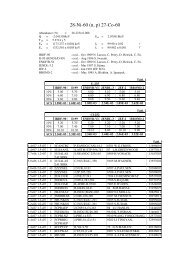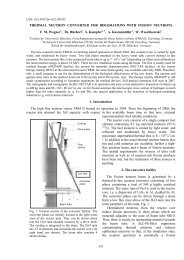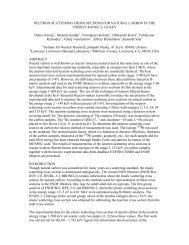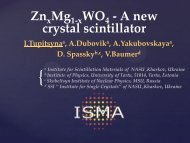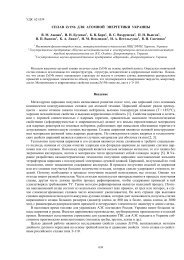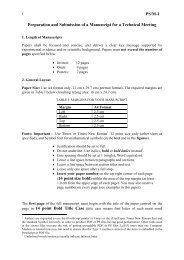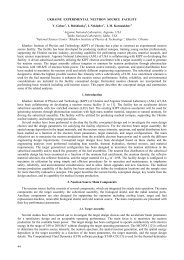Dinh Dang.pdf
Dinh Dang.pdf
Dinh Dang.pdf
You also want an ePaper? Increase the reach of your titles
YUMPU automatically turns print PDFs into web optimized ePapers that Google loves.
2. Outline of the PDM<br />
A. Damping of hot GDR<br />
The quasiparticle representation of the PDM Hamiltonian [5] is obtained by adding the superfluid pairing<br />
interaction and expressing the particle ( p ) and hole ( h ) creation and destruction operators, a † s<br />
and a s<br />
( s = ph , ), in terms of the quasiparticle operators, α † s<br />
and α s<br />
, using the Bogolyubov’s canonical<br />
transformation. As a result, the PDM Hamiltonian for the description of E λ excitations can be written in<br />
spherical basis as<br />
∑ ∑<br />
H = E α α + ω b b +<br />
jm<br />
† †<br />
j jm jm λi λµ i λµ i<br />
λµ i<br />
λ −µ<br />
1 ( −)<br />
( λ ) ( + ) † ( −) † †<br />
+ ∑ f<br />
jj′ { ujj′ [ Ajj′ ( λµ ) Ajj′ ( λµ )] vjj′ [ Bjj′ ( λµ ) Bjj′<br />
( λµ )]}( bλµ i<br />
bλµ<br />
i<br />
)<br />
2 ˆ ∑ + + + + ,<br />
λ ′<br />
λµ i<br />
jj<br />
where ˆ λ = 2λ<br />
+ 1. The first term at the right-hand side (rhs) of Hamiltonian (1) corresponds to the<br />
independent-quasiparticle field. The second term stands for the phonon field described by phonon operators,<br />
†<br />
b λµ i<br />
and b λµ i<br />
, with multipolarity λ , which generate the harmonic collective vibrations such as GDR.<br />
Phonons are ideal bosons within the PDM, i.e. they have no fermion structure. The last term is the coupling<br />
between quasiparticle and phonon fields, which is responsible for the microscopic damping of collective<br />
excitations.<br />
In Eq. (1) the following standard notations are used<br />
∑ ∑ (2)<br />
A ( λµ ) = jmjm ′ ′ | λµ α α , B ( λµ ) =− ( −) j m jmj′ − m′<br />
| λµ α α ,<br />
† † † † ′ − ′<br />
†<br />
jj′ jm j′ m′ jj′ jm j′ m′<br />
mm′ mm′<br />
λ −µ<br />
with ( λµ ) ←→ ( −) ( λ − µ ). Functions ( +<br />
u )<br />
jj′ ≡ ujvj′ + vjuj′<br />
and ( −<br />
v )<br />
jj′ ≡ujuj′ − vjvj′<br />
are combinations of<br />
Bogolyubov’s u and v coefficients. The quasiparticle energy E<br />
j<br />
is calculated from the single-particle<br />
energy ε<br />
j<br />
as<br />
(1)<br />
E<br />
= ( ε − ε ) +∆ , ε ≡ε<br />
− Gv , (3)<br />
2 2 2<br />
j j F<br />
j j j<br />
where the pairing gap ∆ and the Fermi energy ε<br />
F<br />
are defined as solutions of the BCS equations. At T ≠ 0<br />
the thermal pairing gap ∆ ( T ) (or ∆ ( T )) is defined from the finite-temperature BCS (or modified BCS)<br />
equations (See section C below).<br />
The equation for the propagation of the GDR phonon, which is damped due to coupling to the<br />
quasiparticle field, is derived making use of the double-time Green’s function method (introduced by<br />
Bogolyubov and Tyablikov, and developed further by Zubarev). Following the standard procedure of<br />
deriving the equation for the double-time retarded Green’s function with respect to the Hamiltonian (1); one<br />
obtains a closed set of equations for the Green’s functions for phonon and quasiparticle propagators. Making<br />
the Fourier transform into the energy plane E , and expressing all the Green functions in the set in terms of<br />
the one-phonon propagation Green function, we obtain the equation for the latter, G ( E)<br />
, in the form<br />
λ i<br />
G<br />
λi<br />
1 1<br />
( E)<br />
= 2 π E −ω λ i<br />
−P λ i( E)<br />
,<br />
(4)<br />
where the explicit form of the polarization operator Pλ i<br />
( E)<br />
is<br />
( + ) 2 ( −) 2<br />
( u<br />
( ) 2 jj<br />
) (1 nj nj )(<br />
j j<br />
) ( vjj ) ( nj nj )(<br />
j j<br />
)<br />
λ ′ − − ′ ε + ε ′ ′ − ′ ε −ε<br />
′<br />
2 jj′<br />
2 2 2 2<br />
jj′ E − ε<br />
j<br />
+ ε<br />
j′ E − ε<br />
j<br />
−ε<br />
j′<br />
1<br />
Pλ<br />
i( E) = ∑ [ f ] [ − ].<br />
(5)<br />
ˆ λ<br />
( ) ( )<br />
The polarization operator (5) appears due to ph – phonon coupling in the last term of the rhs of<br />
Hamiltonian (1). The phonon damping γ ( ω ) (ω real) is obtained as the imaginary part of the analytic<br />
λi<br />
71



